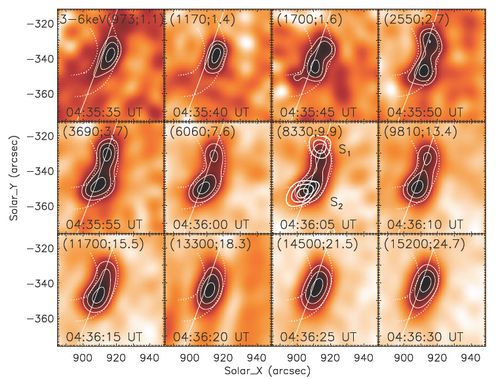We explore the 3–8 keV X-ray source motion along the flaring loop legs in two solar flares observed by the Reuven Ramaty High Energy Solar Spectroscopic Imager (RHESSI) on August 12 and November 28, 2002. Figure 1 shows the example of sources at 3-6 keV for the November 28 2002 flare. Firstly, an artificial loop is constructed to have an outline with a fixed width wide enough to cover the X-ray sources at an energy band between 3–60 keV and at various times. Then, the X-ray source motions are traced from the brightness distribution along the flaring loop. We find that these two events tend to start as a single source at 3–8 keV around the loop top, and then separate into two which move downward along the loop legs. These two almost reach the feet of the loop at the hard X-ray (i.e. at 25–50 keV) peak. After that, the two sources move back upward to the loop top and merge together at the same position where they began. The typical timescale is about ∼70 s, and the maximum speed can reach 1000 km s−1. Such a downward-to-upward motion along the loop is rarely seen in the observations, and it seems to be consistent with the density evolution at the loop top, first decreasing after heating and then increasing due to evaporation. 
By with NING Zongjun RHESSI images at 3–6keV for the November 28, 2002flare. The contour levels (thin at 3–6 keV, thick at 25–28 keV) are set at 70 %, 80 %, and 90 % of the maximum brightness for each image. Two dotted lines sketch the flare loops. Total counts and maximum brightness are given for each image. The work by NIING Zongjun has been accepted to be published in Astrophysics and Space Science (http://link.springer.com/article/10.1007%2Fs10509-013-1461-y) |
